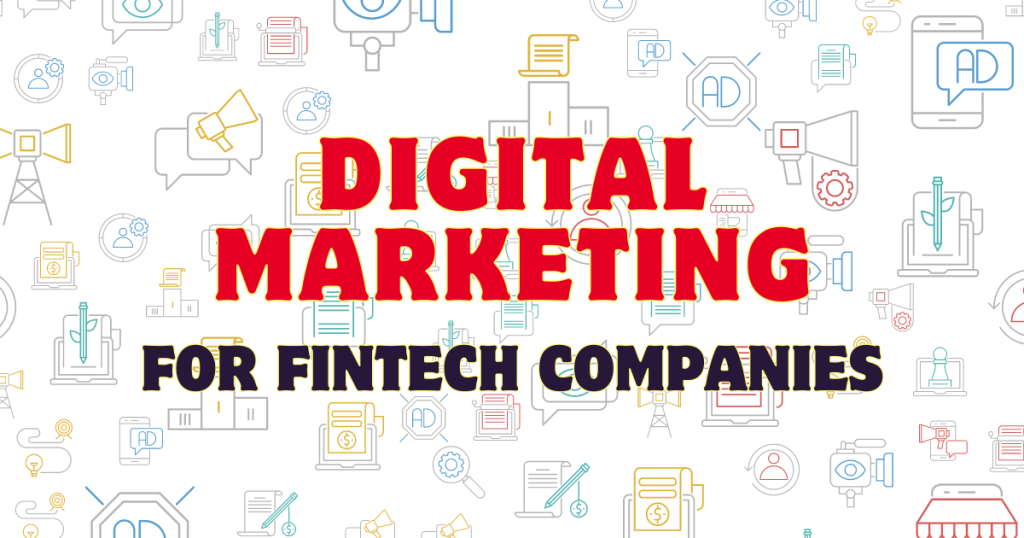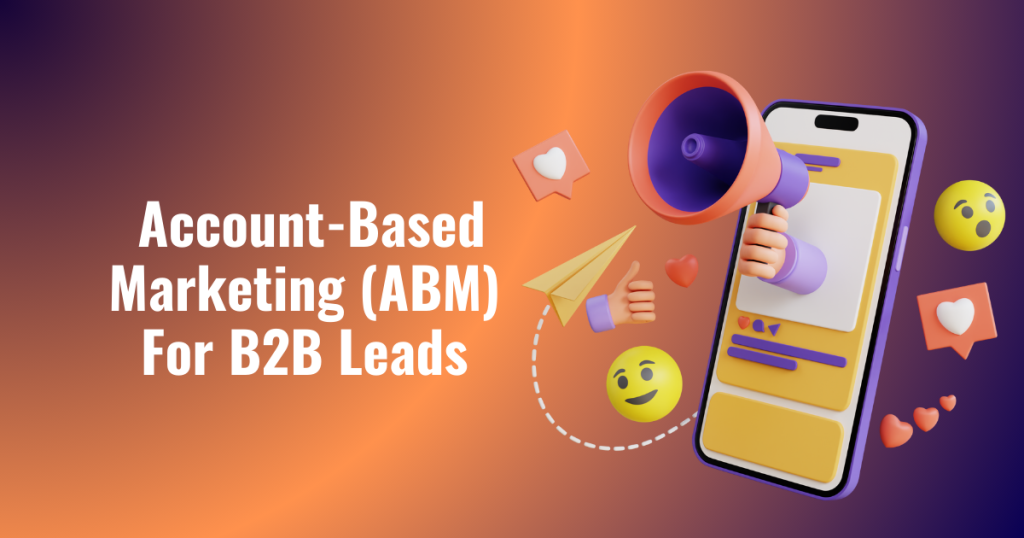Fintech Lead Generation: Top Fintech Marketing Strategies 2024
If you’re looking into lead generation for your fintech company, you might want to know how other fintech startups have managed to get leads. In the fast-paced world of financial technology, mastering fintech lead generation is key to success. Businesses are now embracing B2B fintech marketing and recognizing the power of digital marketing for fintech companies.
This article breaks down fintech lead generation, showing how combining B2B fintech marketing with digital strategies can drive growth and establish market dominance. Join us to explore how these tactics can give your fintech venture a competitive edge in the evolving tech-driven financial landscape.
- What is Fintech Lead Generation?
- What is B2B fintech marketing?
- Is Fintech Lead Generation Primarily Focused On B2B, Or Does It Also Target B2C Markets?
- Understanding The Crucial Differences: B2B Vs. B2C Fintech Marketing
- Why Is Digital Marketing For Fintech Companies A Must?
- Fintech Lead Generation: B2b Fintech Marketing Strategies
- Deep Dive Into Account-Based Marketing (ABM) For B2B Leads:
- Final Thoughts
What is Fintech Lead Generation?
A “lead” is a person who is interested in what a company is selling. Lead generation is the process of creating interest among potential buyers for a product or service and aiming to convert this interest into a purchase. FinTech lead generation is a process where companies that offer technology services or products for businesses (B2B) find and connect with potential customers or clients in the financial sector (like banks or insurance companies). Fintech companies connect with finance professionals like Chief Financial Officers, accountants, bankers, and specialists in pensions and insurance.
What is B2B fintech marketing?

B2B marketing, short for “business-to-business” marketing, refers to the strategies and practices that a company uses to promote its products or services to other businesses, not to individual consumers. This type of marketing is focused on the needs, interests, and challenges of individuals who are making purchases on behalf of their organization, rather than for personal use.
B2B fintech marketing is a specialized approach used by companies in the financial technology sector to market their products and services to other businesses. This form of marketing is different from consumer-oriented marketing as it targets specific businesses within the financial industry, such as banks, insurance companies, and investment firms.
Is Fintech Lead Generation Primarily Focused On B2B, Or Does It Also Target B2C Markets?
Fintech lead generation typically focuses on B2B (business-to-business) marketing rather than B2C (business-to-consumer) marketing. This is because fintech companies often offer products and services that are specialized and targeted towards businesses in the financial industry, such as banks, insurance companies, investment firms, and other financial institutions. These products and services might include payment processing solutions, financial data analytics, risk management tools, and other technologies that are more relevant to businesses than individual consumers.
However, this doesn’t mean fintech companies completely ignore the B2C market. Some fintech products, especially those related to personal finance, payment apps, or consumer banking solutions, might also have a B2C component where they directly target individual consumers. In such cases, fintech companies may employ lead generation strategies that are more typical of B2C marketing, such as social media advertising, content marketing aimed at consumers, and partnerships with consumer-oriented platforms.
Understanding The Crucial Differences: B2B Vs. B2C Fintech Marketing
In the cutthroat world of finance, generating high-quality leads is the lifeline for any fintech company. But navigating the b2b fintech marketing landscape requires nuanced strategies tailored not just to the industry but also to the target audience. While both B2B and B2C approaches strive for conversions, failing to grasp their fundamental differences can lead to messaging that falls flat, wasted resources, and missed opportunities for exponential growth.
Here’s why distinguishing B2B fintech marketing from its B2C counterpart is crucial for achieving fintech lead generation success:
1. Targeting the Right Decision-Makers:
- B2B: You’re not selling to one person, but to a team of stakeholders with diverse priorities and a focus on data-driven solutions, ROI, and robust security. Think industry conferences, white papers, and targeted LinkedIn campaigns.
- B2C: Your audience is broad, with varying financial literacy and needs. Emotional appeal, user-friendliness, and convenience reign supreme. Social media, influencer marketing, and engaging mobile apps are your allies.
2. Nurturing Leads Across Different Stages:
- B2B: The buyer’s journey is a marathon, not a sprint. Extensive research, comparisons, and building trust are essential. Webinars, case studies, and personalized email nurturing campaigns pave the way.
- B2C: Decisions can be impulsive, driven by relatable content, testimonials, and social proof. Short, informative videos, user stories, and easy sign-up processes fuel your lead generation engine.
3. Crafting messages that resonate:
- B2B: Highlight technical features, industry jargon, and data-backed insights. Showcase your expertise in solving specific pain points and delivering measurable results.
- B2C: Keep it simple, personal, and emotionally engaging. Focus on benefits, user experiences, and how your product simplifies their financial lives. Think catchy taglines and visually appealing content.
4. Choosing the Optimal Channels:
- B2B: LinkedIn reigns supreme, along with industry events, trade publications, and targeted online advertising. Cater your message to specific job titles and decision-makers within relevant companies.
- B2C: Social media platforms like Facebook and Instagram are your bullhorn. Partner with relevant influencers, leverage user-generated content, and don’t forget the power of mobile app marketing.
5. Measuring Success Accurately:
- B2B: Go beyond vanity metrics. Track qualified leads, customer lifetime value, and brand awareness among key decision-makers.
- B2C: App downloads, user engagement, transaction volume, and customer acquisition cost paint a clearer picture of your success.
Why Is Digital Marketing For Fintech Companies A Must?

In 2024, digital marketing for fintech companies will be crucial to keeping up in a fast-moving market. The fintech industry is growing rapidly, especially in Asia-Pacific, with more than 60% of people worldwide using fintech services. Even though investment in fintech dipped to $164.1 billion in 2022, it’s still a strong market, showing the need for good digital marketing.
E-commerce drives fintech growth, and the use of fintech platforms has increased globally. This means there’s a big audience for fintech companies to reach online. Also, with most people expected to use mobile payments and AI taking over customer interactions, fintech companies need to include these in their marketing plans.
The large amount of fintech investment in the US and Asia-Pacific shows that different regions are important for digital marketing. This emphasizes digital marketing’s role in getting customers, entering new markets, and growing fintech businesses.
Fintech Lead Generation: B2b Fintech Marketing Strategies
Dive into the realm of fintech lead generation with a focus on B2B strategies. Explore innovative B2B fintech marketing tactics that elevate financial technology enterprises to new heights.
Content Marketing On LinkedIn
According to the B2B Content Marketing 2020 Benchmarks report, LinkedIn emerges as the top choice for both organic and paid social media platforms among B2B marketers. It also proves to be a proactive platform for users, with a significant 80% of fintech lead generation occurring on LinkedIn, as revealed by the platform’s data. Simplus, a key player in the field, reports that a substantial 70% of their form submissions are directly attributed to LinkedIn.
The most effective strategy for attracting B2 fintech marketing potential customers (leads) is straightforward: consistently share engaging articles on LinkedIn, respond to queries from those interested in your services, and discuss current trends in the financial market. In 2024, it’s the opportune moment to build connections and engage with individuals in your specific industry, understanding their challenges and offering solutions to address their needs and concerns.
Deliver Free Tools And Resources By Creating Videos
One effective lead generation strategy for tech companies is to demonstrate the practical applications of their software through video presentations. Videos are highly effective for message delivery, with a 95% retention rate for video messages compared to just 10% for text. Giving away a helpful portion of your software for free on your website (in exchange for contact information) and keeping more useful and advanced options as a premium subscription gives potential customers a sneak peek at what you offer, allowing you to encourage them to experience the complete package. Additionally, it can be used for retargeting, offering discounts on the entire product, which tends to have a significantly high conversion rate.
In the fintech sector, lead generation can be effectively enhanced by using a variety of video formats, including instructional guides, step-by-step how-to videos, detailed explainer videos, recorded webinars, and informative educational material. Incorporating customer success stories, testimonials, and an ongoing series on industry insights can further enrich your video marketing strategy.
Get Influencers To Market Your Product
Social influencer marketing involves leveraging the popularity of social media personalities to promote products on their channels. Leveraging the right influencer can significantly enhance your sales, establish your brand’s authority, and increase awareness. Particularly for new products, as a study by Oracle noted, influencer marketing can be a key component of your launch strategy, with 28 percent of consumers discovering new products and brands through social media influencers.
Actively Participate In Industry Events
Building meaningful relationships through active participation in industry events and networking is essential for fintech lead generation in high-ticket enterprises and B2B sales.
Attending fintech events offers a gold mine of networking opportunities. These events simplify lead capture through digital platforms, making contact exchange effortless. Additionally, you gain insights from industry experts, boosting your credibility. Showcasing your fintech solutions to a focused audience can result in valuable leads, while in-person meetings foster trust and rapport. Market research and post-event follow-up are essential for refining your offerings and converting interactions into leads. Consistent event participation enhances brand visibility, attracting more potential leads. Lastly, don’t overlook collaboration prospects that can emerge, opening new doors for lead generation in the dynamic fintech sector.
Niche Podcast
It sounds like fintech companies are recognizing the power of podcasts to reach and engage their target audience. Podcasts offer a unique opportunity to connect with potential customers on a more personal level and to build relationships with them over time. By sponsoring podcasts, fintech companies can get their brand in front of a highly engaged and interested audience.
Use Data to Find Your Ideal Customers
Sometimes, having a single highly interested lead is more valuable than having many who aren’t that interested. When it comes to getting high-quality technology leads, the key is to connect with the right people at the right time. This means reaching out to them when they’re actively considering buying a product like yours. By using a technique known as ‘intent data targeting,’ you can connect with your ideal customers precisely when they are actively searching for information about what you offer.
Optimize Your Website for Trust, Engagement, and Action
Making your website easy to use on smartphones is very important. Think about it: there are billions of smartphone users around the world, and people use their phones for just about everything, including managing their money. So, if you have a fintech app, making sure people can easily use it on their phones is key.
Building a user-friendly website for fintech lead generation is all about balancing a welcoming aesthetic with clear information and easy conversion pathways. Keep it simple to navigate, explain complex concepts clearly, and highlight how your products or services solve users’ problems. Showcase your credibility with security measures, testimonials, and team bios. Use prominent CTAs, ensure fast loading times, and have clear, easy-to-click buttons, landing pages, and short forms to capture leads. Engage users with informative content, visuals, and interactive elements. Use a website builder platform like Wix, Squarespace, and WordPress.com, or hire a professional web designer and developers. They can handle the entire website creation process, from design and development to content creation and SEO.
Invest In SEO
SEO is really valuable, and it’s surprising how many tech companies don’t use it well. It can bring a lot of benefits without costing much. The key is to find the right keywords that people are searching for and use them in your website’s text and other content in a natural way. This isn’t too hard and there are tools like Semrush that can help you find specific, longer keywords (called long-tail keywords) that work really well. Good SEO can last a long time. If you do a great job with your content and use the right keywords better than your competitors, your website can stay high up in Google’s search results for years, continuously bringing in new leads.
Educate Your Audience By Creating Quality Content
To effectively educate customers, fintech companies can utilize a variety of methods. Producing short, engaging videos and sharing them on social media platforms such as YouTube, TikTok, and Instagram is a powerful approach. These videos can break down complex financial concepts into digestible information, making learning both accessible and enjoyable.
Content writing is the secret weapon for lead generation. It builds trust, educates your audience, attracts the right prospects, nurtures leads, and positions you as an industry thought leader. By crafting valuable content for your website, you’re not just writing words; you’re building a bridge to loyal customers and financial success. So, invest in impactful content, embrace storytelling, and watch your fintech business flourish with effective digital marketing for fintech companies.
Content Distribution
What is content distribution in marketing? Well, content distribution in B2B marketing means sharing your organization’s content with third-party suppliers, platforms, and websites that you don’t own. The main goal of content distribution in B2B fintech marketing is to get valuable leads. If you want to connect with technology audiences who are not easy to find, content distribution can be a very detailed way to generate leads in the technology field. Content distribution involves sharing your marketing materials, like whitepapers, research reports, eBooks, or webinar recordings, on websites that you don’t own. These websites are often called content distribution platforms. Content distribution is super helpful for tech marketers because nowadays, many people are involved in buying tech stuff. Using content distribution ensures that your brand and lead-generation strategies reach as many people as possible.
Deep Dive Into Account-Based Marketing (ABM) For B2B Leads:

Account-Based Marketing (ABM) in B2B fintech is like fishing for big, important clients. Instead of trying to catch many fish, you focus on targeting a few ‘whales’ – those high-value clients who can really boost your business. To do this, you need to follow some steps:
Identify Your Targets:
First, you need to do some careful research to find out which companies and decision-makers you want to go after. Think about things like whether they’re a good fit for your business, how big they are, what problems they have, and how much money they could bring in. Use special tools to gather lots of information about these targets.
Personalize Your Approach:
Don’t just send them generic information. Create special content that talks directly to their specific issues and goals. Make case studies that show how you’ve helped similar companies in their industry. Write blogs and papers that address their problems directly.
Go Beyond Content:
ABM isn’t just about sending stuff. You can organize special online events and webinars that are interesting to your target clients. You can also connect with them on social media, especially on platforms like LinkedIn.
Connect Personally:
Don’t be afraid to call them on the phone. Personalized communication helps you understand what they really need and show them how you can help.
Build Relationships:
ABM is not a quick thing; it’s a long process. You need to keep in touch with your target clients regularly. Send them personalized content, invite them to events, and talk to them directly. Show them you’re not just trying to sell something, but that you really understand their business.
Use Data to Improve:
Keep an eye on how well your ABM efforts are working. Look at things like how engaged your targets are, how many people visit your website, and how many leads you’re getting. Use this information to make your approach even better and get the most out of your efforts.
Read More:
- How Does Fintech Make Money?
- How To Launch A Fintech
- Fintech Management Consulting
- How Chatbot Helps In Fintech
Final Thoughts
Forget one-note marketing! Fintech lead generation thrives on a diverse orchestra. B2B fintech marketing serenades professionals with data-driven white papers on LinkedIn, while B2C fintech rocks social media with user stories and influencer beats. The conductor? Digital marketing expertly blends SEO, content, and analytics for a chorus of conversions. Master the melody, and your fintech brand will attract leads like groupies, turning them into loyal fans. So grab your digital instruments and let the fintech lead-generation symphony begin!
FAQs
Q1: What is lead generation in the banking sector?
Lead generation in the banking sector involves the process of identifying and attracting potential customers or clients who have expressed interest in banking products or services. It aims to create qualified leads that can be pursued and converted into customers through targeted marketing efforts. The goal is to cultivate a pipeline of individuals or businesses interested in banking solutions, ultimately driving growth and expanding the customer base.
Q2: Who is leading fintech?
The leadership in the fintech industry is dynamic and ever-evolving, with various companies and startups vying for prominence. As of my last knowledge update in January 2022, key players included companies like Stripe, Square, PayPal, and Robinhood, each excelling in different segments of the fintech landscape. However, the competitive landscape may have evolved, and it’s advisable to check the latest industry updates for the most current information on leading fintech companies.
Q3: What is a GTM strategy for fintech?
A Go-To-Market (GTM) strategy for fintech involves a comprehensive plan to introduce and promote financial technology products or services in the market effectively. This strategy typically includes identifying target markets, understanding customer needs, defining unique value propositions, establishing distribution channels, and implementing marketing and sales initiatives. Success in fintech GTM often hinges on building trust, addressing regulatory considerations, and showcasing the innovation and benefits that the technology brings to the financial sector.
Q4: Who is the target market for fintech companies?
The target market for fintech companies varies based on their specific products and services, but generally includes a broad range of consumers and businesses. In the consumer space, fintech often targets tech-savvy individuals seeking convenient and innovative financial solutions, including digital payments, budgeting apps, and investment platforms. In the B2B space, fintech companies may focus on serving financial institutions, banks, corporations, and other businesses looking for advanced tools in areas such as payment processing, risk management, or financial analytics. The diversity of fintech offerings means that target markets can span across demographics, industries, and geographical regions.
Q5: How do you market a B2B fintech?
Marketing a B2B fintech involves a strategic approach tailored to businesses. Key steps include identifying target industries, showcasing the value proposition through case studies and testimonials, leveraging thought leadership content, participating in industry events, and building strong relationships through networking. Digital marketing tools, such as SEO and targeted advertising, play a crucial role in reaching and engaging B2B audiences. Additionally, emphasizing security, compliance, and integration capabilities is essential in addressing the specific needs and concerns of business clients in the fintech sector.






